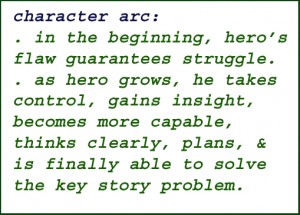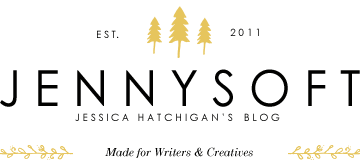 You’ve heard the terms “character arc” and “story arc”?
You’ve heard the terms “character arc” and “story arc”?
What exactly do they mean?
They mean that good story planning (structure) follows a trajectory.
In the beginning, an event causes your hero to take action against an antagonistic force.
Throughout the middle of the story, the stakes grow higher, and the hero struggles with greater intensity against the antagonist. (The antagonist counters each of the hero’s efforts with greater force.)
As the story concludes, the hero, temporarily overwhelmed by the antagonist’s fierce opposition, falters. But then he regroups and prepares (armed with insight he has gained via his struggles) for a last stand. He will either win or lose this final battle.
“Character arc” and “story arc” need to be organically intertwined. Your hero’s characterization needs to support the story arc, and vice-versa.
This means that your hero can’t be perfectly capable of foiling the antagonist from the start. In the opening pages of your novel, you need to show the reader why the hero is (initially) an easy mark for the antagonist. Show us what’s holding the hero back: his weaknesses or fears.
Then, up to the story’s midpoint: show how the hero’s weakness continues to keep him on the defensive against the antagonist. (See previous post on the Midpoint Shift.)
After the midpoint, show the hero shifting from a passive defensive mode to effectively going after the antagonist. This shift should be due to the hero’s gaining new information and/or insight. The new information/insight puts lead in the hero’s pencil. The hero has new knowledge which makes him more effective. In other words, the hero begins to grow.
From the midpoint, the hero begins to have increasing insight into what has held him back. He continues to grow.
By the end of the story, the hero has overcome his weakness and can successfully face the antagonistic force.
So, to recap:
- In the beginning, the hero is flawed in some way. For some reason he is unable to cope well. He may be unhappy for any variety of reasons. He may be grief-stricken, deeply angry, terrifically guilty, or swamped by some other strong emotion.
- By the resolution, the hero has undergone a transformation, sparked by his struggles. He has grown, mastered his flaws, and is now able to plan and solve his problems. He is in control.
In short, the hero is different at the end. Well-structured stories are stories of how the hero met serious challenges and changed in order to deal with those challenges. The hero will either go down to noble defeat (in a tragedy) or win!
Happy writing!

No Comments